Today we are looking at the Corsair Force GT 60GB, which is a LSI-SandForce SF-2281 based solid state drive (SSD) that uses Synchronous ONFi NAND. Previously we reviewed the Corsair Force 3 120GB SSD that used asynchronous NAND and found that while less expensive, the asynchronous NAND did give back some performance versus other drives. The Corsair Force GT 60GB really turns the tables performance wise as the synchronous ONFi NAND is going to get a lot of the sequential performance previously missing on the asynchronous Corsair offering. With 80K IOPS and 555MB/s read and 495MB/s write speeds advertised, the Force GT is going to be a strong solid state drive performer. We do know that 60GB solid state drives tend to suffer a bit in terms of performance because their NAND channels are not completely full. Let’s see if the synchronous NAND can overcome that obstacle and make the Force GT 60GB SSD a high performer.
Test Configuration
I am using a Sandy Bridge test bed here as the Cougar Point SATA 6.0gbps controller is perhaps the best 6.0gbps SATA controller on the market at the moment.
- CPU: Intel Core i5-2500K
- Motherboard: ASUS P8H67-M EVO
- Memory: 8GB 1600MHz CL9 DDR3 (4x2GB)
- OS Drive: OCZ Agility 2 120GB
- Additional Drives: Corsair Force GT 60GB
- Additional NICs: Intel Gigabit CT PCIe x1 network adapter
- Enclosure: Supermicro SC731i-300B
- Power Supply: Supermicro 300w (included in the SC731i-300B)
As with any modern SSD, set the controller to AHCI mode or RAID mode for best performance. Also, installing the Intel RST 10.xx series drivers over the default Windows 7 drivers showed a nice performance gain.
The Tests
It is important, especially with SSDs not to take a single test result at face value. One should look at a few different tests to get an idea of how the drives perform in different scenarios. To this end, AS SSD benchmark, CrystalDiskMark, ATTO and HD Tune Pro all show different facets of performance.
AS SSD Benchmark
AS SSD is a solid benchmark that does not write compressible data to drives. The result is perhaps one of the best workstation SSD benchmarks available today.
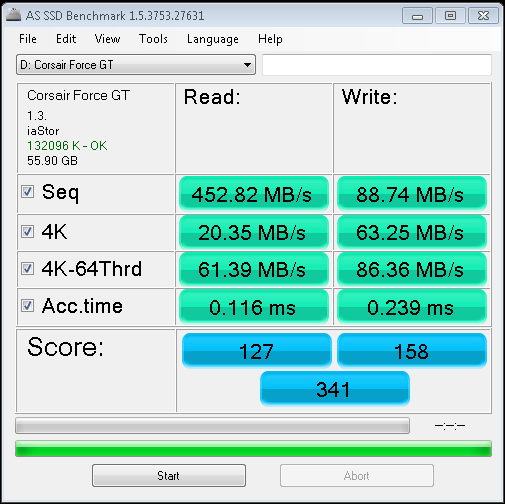
Interestingly enough, we see very similar performance as we did with the Force 3 120GB except in one area, the sequential read speeds. The asynchronous NAND of the Force 3 120GB pushed about 205MB/s in this benchmark. Here, we see a lot of improvement despite having less capacity.
CrystalDiskMark
CrystalDiskMark is another benchmark which gives non-compressible read/write numbers. This is in contrast to the ATTO Benchmark used by LSI/Sandforce and its partners when they market a given solid state drive.
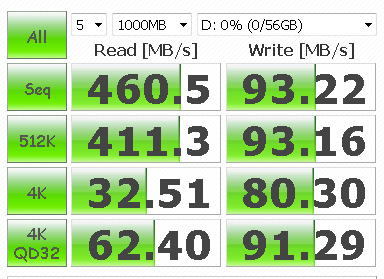
Like we saw with AS SSD, CDM shows more than twice the sequential read speeds of the Corsair Force 3 120GB, and about 50% higher 4K reads thanks to the Corsair Force GT’s synchronous NAND.
ATTO Benchmark
The ATTO Benchmark shows some fairly strong performance, I will note that the value of the ATTO benchmark is really to show the best-case scenario. ATTO is known to write highly compressible data to drives, which inflates speeds of controllers that compress data like SandForce does prior to writing on a given solid state drive.
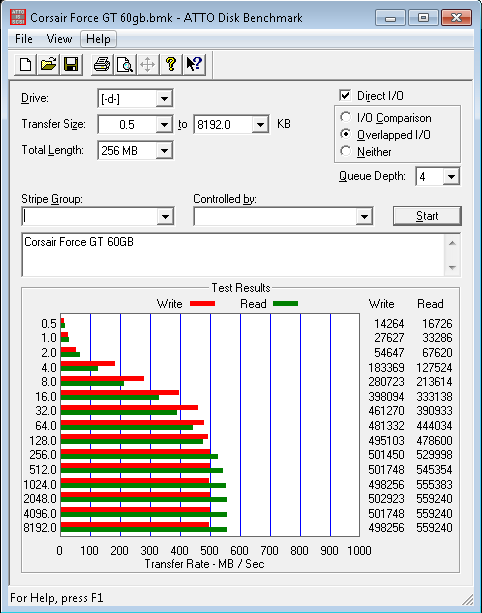
Corsair rates the Force GT 60GB at 555MB/s Read and 495MB/s write primarily based on this ATTO benchmark. One can easily see that the drive does this (and a bit more on the write side.) As we see with other benchmarks, SandForce based drives do very well with compressible data but are not as fast once the data is not able to be compressed by the onboard controller. The 559MB/s figure is pushing the SATA 3 interface towards its limit.
HD Tune Pro
HD Tune and its Pro version have been longstanding disk drive benchmarks. I started including the basic benchmark in reviews since I do test a mix of hard drives and solid state drives.
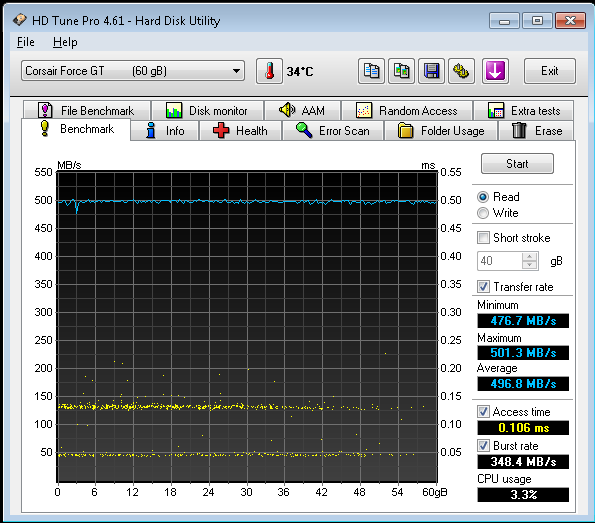
I think this is very similar to what we saw with the Force 3 120GB drive, except that the burst rate is about double the larger drive and the access time is down about 20%. That correlates to what we saw with the similar AS SSD metric.
Conclusion
Overall, the Corsair Force GT 60GB SSD is fast, and can put out significant speeds with compressible data. The 4K random speeds are pretty decent but I have to pause here. On one hand, the synchronous NAND is a nice performance bump, especially with sequential speeds and incompressible data. With synchronous NAND drives retailing for about 10% more than the asynchronous NAND drives, I think it makes sense at this point to buy either synchronous ONFi NAND or toggle NAND drives at this point. Solid state drive prices have really fallen as of late, so this makes a lot of sense. The only reservation I have with the 60GB drive is that it is fairly small. This has a negative impact on performance, but the larger issue is that 60GB drives are still not hovering around $1/ GB like the 120GB drives are and 60GB is perfect for a media center PC, but if one is going to have many applications installed, a 60GB drive is going to seem very small. If I had a 120GB or larger Force GT I think that would be the sweet spot from a performance perspective.
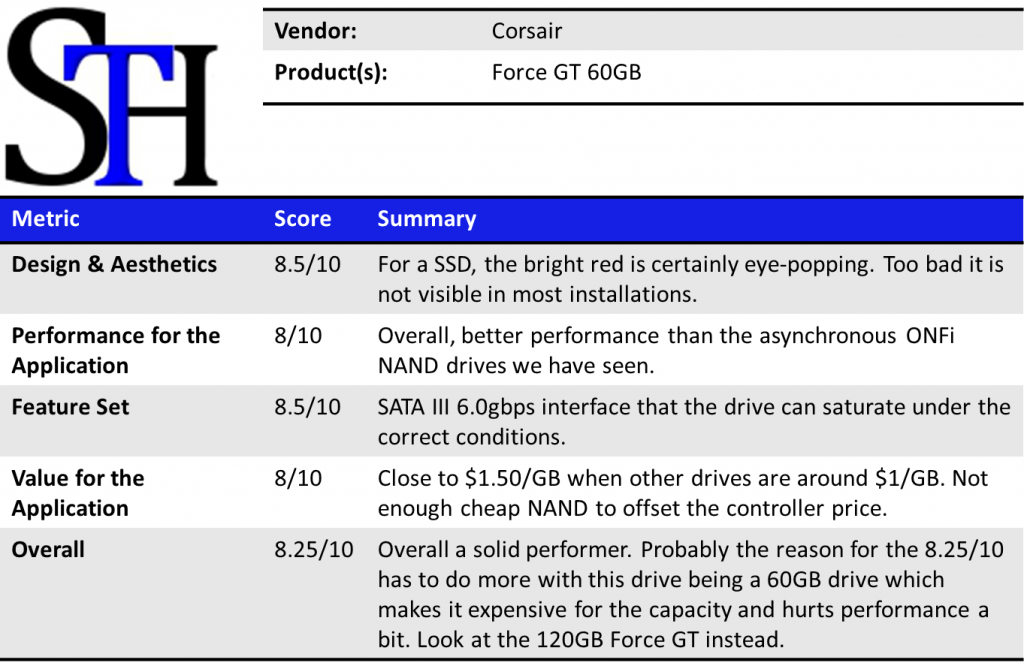




Nice review, I’m really having a hard time choosing between a Force 3 (asynchronous)and Vertex 3 (synchronous). This helps me to choose for synchronous